Showing Spotlights 17 - 24 of 40 in category All (newest first):
 The study focused on the following questions: What do consumers know about nanotechnologies? How do they rate nanotechnologies? How do they obtain information? How would they like to be informed in the future? The results show that the "Nano-Hype" appears to be fading. Surprisingly, regarding the quality of the consumers' statements, e.g. how detailed their descriptions of the individual examples are, it can be said that their knowledge about all fields of application has decreased. Even though the knowledge about all fields of application has decreased, particularly striking is the decline in the fields of surface coatings, construction materials and environmental engineering. In sum, it can be hypothesised that consumer communication on the part of product manufacturers has decreased considerably, or that the information does not reach the target group to the same extent. The public knowledge on nanotechnologies has become more abstract.
The study focused on the following questions: What do consumers know about nanotechnologies? How do they rate nanotechnologies? How do they obtain information? How would they like to be informed in the future? The results show that the "Nano-Hype" appears to be fading. Surprisingly, regarding the quality of the consumers' statements, e.g. how detailed their descriptions of the individual examples are, it can be said that their knowledge about all fields of application has decreased. Even though the knowledge about all fields of application has decreased, particularly striking is the decline in the fields of surface coatings, construction materials and environmental engineering. In sum, it can be hypothesised that consumer communication on the part of product manufacturers has decreased considerably, or that the information does not reach the target group to the same extent. The public knowledge on nanotechnologies has become more abstract.
May 2nd, 2012
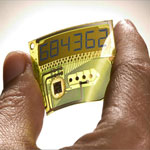 Printed electronics has its origins in conductive patterns printed as part of conventional electronics, forming flexible keyboards, antennas and so on. Then came fully printed testers on batteries, electronic skin patches and other devices made entirely by printing, including batteries and displays. A clear next step has been to modernise static print with the e-reader and the talking poster with animated, light emitting display and solar power. These are partly or almost wholly printed, with a clear roadmap to making them lower cost and more reliable and flexible by using printing more fully in their manufacture in future. However, we now see printed electronics and electrics certain to penetrate far more applications than anyone realised.
Printed electronics has its origins in conductive patterns printed as part of conventional electronics, forming flexible keyboards, antennas and so on. Then came fully printed testers on batteries, electronic skin patches and other devices made entirely by printing, including batteries and displays. A clear next step has been to modernise static print with the e-reader and the talking poster with animated, light emitting display and solar power. These are partly or almost wholly printed, with a clear roadmap to making them lower cost and more reliable and flexible by using printing more fully in their manufacture in future. However, we now see printed electronics and electrics certain to penetrate far more applications than anyone realised.
Feb 15th, 2011
 The automotive sector is a major consumer of material technologies - and nanotechnologies promise to improve the performance of existing technologies significantly. Applications range from already existing - paint quality, fuel cells, batteries, wear-resistant tires, lighter but stronger materials, ultra-thin anti-glare layers for windows and mirrors - to the futuristic - energy-harvesting bodywork, fully self-repairing paint, switchable colors, shape-shifting skin. The basic trends that nanotechnology enables for the automobile are: lighter but stronger materials; improved engine efficiency and fuel consumption for gasoline-powered cars; reduced environmental impact from hydrogen and fuel cell-powered cars; improved and miniaturized electronic systems; and better economies. This article provides an overview of a large number of efforts and applications involving nanotechnologies in the automotive industry.
The automotive sector is a major consumer of material technologies - and nanotechnologies promise to improve the performance of existing technologies significantly. Applications range from already existing - paint quality, fuel cells, batteries, wear-resistant tires, lighter but stronger materials, ultra-thin anti-glare layers for windows and mirrors - to the futuristic - energy-harvesting bodywork, fully self-repairing paint, switchable colors, shape-shifting skin. The basic trends that nanotechnology enables for the automobile are: lighter but stronger materials; improved engine efficiency and fuel consumption for gasoline-powered cars; reduced environmental impact from hydrogen and fuel cell-powered cars; improved and miniaturized electronic systems; and better economies. This article provides an overview of a large number of efforts and applications involving nanotechnologies in the automotive industry.
Nov 12th, 2010
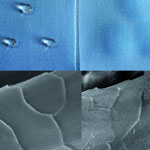 Nanotechnology shows great potential for revolutionizing the textile industry across its entire range of applications with its ability to impart new functionality to textiles while at the same time maintaining their look and feel. The wool textile industry, for example, is researching the development of textiles with fast-absorbing and quick-drying properties. This has great importance for improving clothing thermophysiological comfort and wearing performance by adjusting the transport of heat and moisture through a fabric which was usually achieved using synthetic fibers. One stubborn hurdle that prevents nanotechnology-enabled 'smart' textiles from becoming more of a commercial reality is the insufficient durability of nanocoatings on textile fibers or the stability of various properties endowed by nanoparticles. Quite simply put, the 'smart' comes off during washing. Developing an effective approach to enhance the coalesce force between nanoparticles and wool fibers has great significance both in scientific and real applications of nanotechnology functionalized textiles.
Nanotechnology shows great potential for revolutionizing the textile industry across its entire range of applications with its ability to impart new functionality to textiles while at the same time maintaining their look and feel. The wool textile industry, for example, is researching the development of textiles with fast-absorbing and quick-drying properties. This has great importance for improving clothing thermophysiological comfort and wearing performance by adjusting the transport of heat and moisture through a fabric which was usually achieved using synthetic fibers. One stubborn hurdle that prevents nanotechnology-enabled 'smart' textiles from becoming more of a commercial reality is the insufficient durability of nanocoatings on textile fibers or the stability of various properties endowed by nanoparticles. Quite simply put, the 'smart' comes off during washing. Developing an effective approach to enhance the coalesce force between nanoparticles and wool fibers has great significance both in scientific and real applications of nanotechnology functionalized textiles.
Oct 12th, 2010
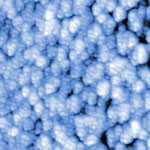 Quite a lot of nanotechnology research and manufacturing efforts go into synthesizing metal-based nanoparticles. Unfortunately, some of the nanoparticle manufacturing processes themselves as well as the final nanoparticle materials may be of potential concern for environmental regulators and for researchers attempting to address nanomaterial toxicity. As an alternative to using these potentially hazardous metal-based nanoparticles, some researchers are suggesting the use of naturally occurring nanoparticles. However, this area has not yet been well explored with regard to natural nanoparticles' diverse properties and potential applications. Researchers have now made the discovery that naturally occurring nanoparticles have unique optical properties. In addition, they are less toxic and biodegradable than their synthesized, metal-based counterparts. This discovery makes it likely that scientists will be able to find more biocompatible nanoparticles to replace metal-based nanoparticles, predominantly for biomedical applications.
Quite a lot of nanotechnology research and manufacturing efforts go into synthesizing metal-based nanoparticles. Unfortunately, some of the nanoparticle manufacturing processes themselves as well as the final nanoparticle materials may be of potential concern for environmental regulators and for researchers attempting to address nanomaterial toxicity. As an alternative to using these potentially hazardous metal-based nanoparticles, some researchers are suggesting the use of naturally occurring nanoparticles. However, this area has not yet been well explored with regard to natural nanoparticles' diverse properties and potential applications. Researchers have now made the discovery that naturally occurring nanoparticles have unique optical properties. In addition, they are less toxic and biodegradable than their synthesized, metal-based counterparts. This discovery makes it likely that scientists will be able to find more biocompatible nanoparticles to replace metal-based nanoparticles, predominantly for biomedical applications.
Jul 21st, 2010
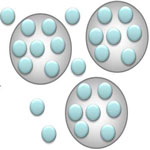 With all the buzz that is being created by portable e-book readers, it's worth taking a look at one of the advanced display technologies - also often referred to as electronic paper - that make these devices happen. Unlike a conventional flat panel display, which uses a power-consuming backlight to illuminate its pixels, electronic paper reflects light like ordinary paper and is capable of holding text and images indefinitely without drawing electricity, while allowing the image to be changed later. Because they can be produced on thin, flexible substrates an due to their paper-like appearance, electrophoretic displays are considered prime examples of the electronic paper category. Electrophoretic displays already are in commercial use, for instance in the Kindle or in the Sony Reader, but so far the displays are mostly black and white. There are still cost and quality issues with color displays. New work by researchers in South Korea shows that organic ink nanoparticles could provide an improved electronic ink fabrication technology resulting in e-paper with high brightness, good contrast ratio, and lower manufacturing cost.
With all the buzz that is being created by portable e-book readers, it's worth taking a look at one of the advanced display technologies - also often referred to as electronic paper - that make these devices happen. Unlike a conventional flat panel display, which uses a power-consuming backlight to illuminate its pixels, electronic paper reflects light like ordinary paper and is capable of holding text and images indefinitely without drawing electricity, while allowing the image to be changed later. Because they can be produced on thin, flexible substrates an due to their paper-like appearance, electrophoretic displays are considered prime examples of the electronic paper category. Electrophoretic displays already are in commercial use, for instance in the Kindle or in the Sony Reader, but so far the displays are mostly black and white. There are still cost and quality issues with color displays. New work by researchers in South Korea shows that organic ink nanoparticles could provide an improved electronic ink fabrication technology resulting in e-paper with high brightness, good contrast ratio, and lower manufacturing cost.
Jan 27th, 2010
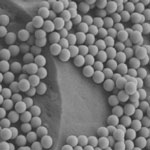 One important aspect of clothing comfort is thermo-physiological comfort. By adjusting the transport of heat and moisture through a fabric, thermo-physiological comfort can keep people comfortable with regard to temperature and moisture. Some hydrophobic fabrics have deficiencies in this area. Take wool. Wool is one of the best insulating fibers known to man - while at the same time being light and soft. The quality that distinguishes wool fibers is the presence of a fatty, water-repellent outer layer that surrounds each fiber. Therefore, the water absorption and sweat venting properties of wool fiber are not very good, which affects the wearing comfort of wool textiles. The wool hydrophobic surface layer is also a barrier to anticrease finishing, dyeing, and grafting of hydrophilic agents, which is an issue in trying to add smart functionalities to wool fabrics.
Researchers have now developed a simple method for fabricating environmentally stable superhydrophilic wool fabrics. They applied silica sols to natural wool fibers to form an ultrathin layer on the surface of the fibers.
One important aspect of clothing comfort is thermo-physiological comfort. By adjusting the transport of heat and moisture through a fabric, thermo-physiological comfort can keep people comfortable with regard to temperature and moisture. Some hydrophobic fabrics have deficiencies in this area. Take wool. Wool is one of the best insulating fibers known to man - while at the same time being light and soft. The quality that distinguishes wool fibers is the presence of a fatty, water-repellent outer layer that surrounds each fiber. Therefore, the water absorption and sweat venting properties of wool fiber are not very good, which affects the wearing comfort of wool textiles. The wool hydrophobic surface layer is also a barrier to anticrease finishing, dyeing, and grafting of hydrophilic agents, which is an issue in trying to add smart functionalities to wool fabrics.
Researchers have now developed a simple method for fabricating environmentally stable superhydrophilic wool fabrics. They applied silica sols to natural wool fibers to form an ultrathin layer on the surface of the fibers.
Jan 15th, 2010
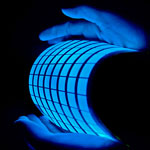 OLEDs - organic light-emitting diodes - are full of promise for a range of practical applications. With more efficient and cheaper OLED technologies it becomes possible to make ultraflat, very bright and power-saving OLED televisions, windows that could be used as light source at night, and large-scale organic solar cells. One of the drawbacks of this technology, apart from its currently high manufacturing cost, are problems with the OLED fabrication process where issues such as material damage, yield, and thickness uniformity haven't been completely solved yet. Researchers in Japan have now proposed a nanoparticle-based deposition method that might be able to overcome these fabrication problems.
OLEDs - organic light-emitting diodes - are full of promise for a range of practical applications. With more efficient and cheaper OLED technologies it becomes possible to make ultraflat, very bright and power-saving OLED televisions, windows that could be used as light source at night, and large-scale organic solar cells. One of the drawbacks of this technology, apart from its currently high manufacturing cost, are problems with the OLED fabrication process where issues such as material damage, yield, and thickness uniformity haven't been completely solved yet. Researchers in Japan have now proposed a nanoparticle-based deposition method that might be able to overcome these fabrication problems.
Nov 23rd, 2009
 The study focused on the following questions: What do consumers know about nanotechnologies? How do they rate nanotechnologies? How do they obtain information? How would they like to be informed in the future? The results show that the "Nano-Hype" appears to be fading. Surprisingly, regarding the quality of the consumers' statements, e.g. how detailed their descriptions of the individual examples are, it can be said that their knowledge about all fields of application has decreased. Even though the knowledge about all fields of application has decreased, particularly striking is the decline in the fields of surface coatings, construction materials and environmental engineering. In sum, it can be hypothesised that consumer communication on the part of product manufacturers has decreased considerably, or that the information does not reach the target group to the same extent. The public knowledge on nanotechnologies has become more abstract.
The study focused on the following questions: What do consumers know about nanotechnologies? How do they rate nanotechnologies? How do they obtain information? How would they like to be informed in the future? The results show that the "Nano-Hype" appears to be fading. Surprisingly, regarding the quality of the consumers' statements, e.g. how detailed their descriptions of the individual examples are, it can be said that their knowledge about all fields of application has decreased. Even though the knowledge about all fields of application has decreased, particularly striking is the decline in the fields of surface coatings, construction materials and environmental engineering. In sum, it can be hypothesised that consumer communication on the part of product manufacturers has decreased considerably, or that the information does not reach the target group to the same extent. The public knowledge on nanotechnologies has become more abstract.

 Subscribe to our Nanotechnology Spotlight feed
Subscribe to our Nanotechnology Spotlight feed





